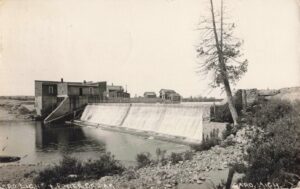In the early 1900s, Caro, Michigan, embraced hydroelectricity as part of a broader movement to harness water power for community growth and modernization. The Caro Light & Power Company constructed this dam and power plant to serve the town’s electrical needs, using the flow of local waterways to generate renewable energy.
The dam, built of stone and reinforced with concrete, held back water to create a controlled flow that powered turbines within the plant’s adjacent wooden powerhouse. The water’s force turned large mechanical wheels connected to generators, producing electricity that supplied homes, businesses, and streetlights throughout Caro—a remarkable achievement for a small-town utility in that era.
This hydroelectric plant was considered high progress at a time when rural electrification was still rare. By investing in local power generation, Caro joined a growing number of Michigan towns looking to break reliance on coal and gas by using their natural resources. Hydroelectric plants like this were clean and relatively cost-effective, providing a sustainable energy source before the nationwide expansion of centralized grids.




